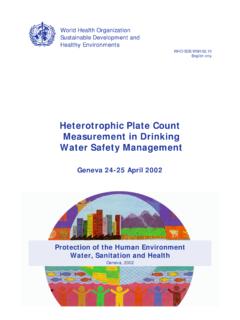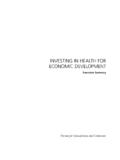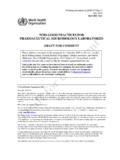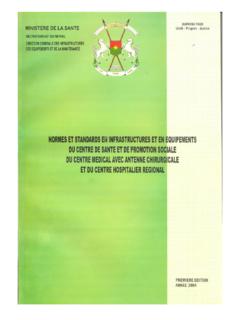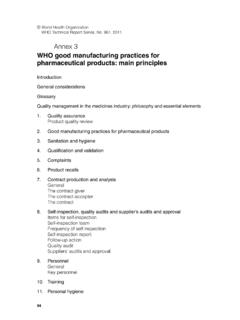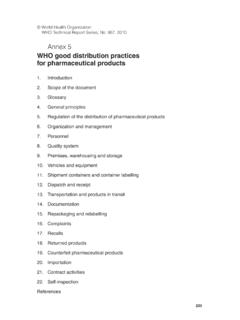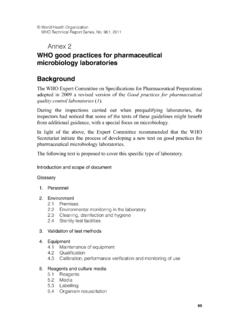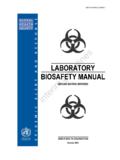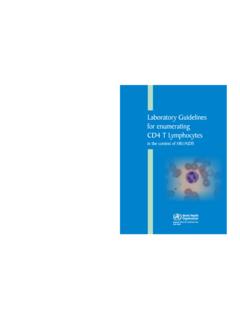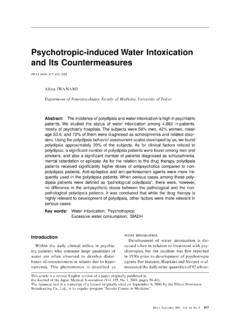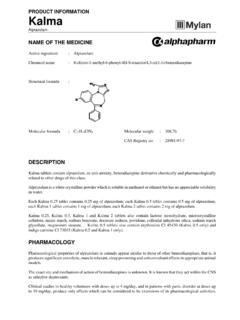Transcription of CANNABIDIOL (CBD) Pre-Review Report - WHO
1 CANNABIDIOL (CBD) Pre-Review Report Agenda Item Expert Committee on Drug Dependence Thirty-ninth Meeting Geneva, 6-10 November 2017 39th ECDD (2017) Agenda item CANNABIDIOL (CBD) Page 2 of 27 Contents Acknowledgements .. 4 Summary .. 5 1. Substance identification .. 6 A. International Nonproprietary Name (INN) .. 6 B. Chemical Abstract Service (CAS) Registry Number .. 6 C. Other Chemical Names .. 6 D. Trade Names .. 6 E. Street Names .. 6 F. Physical Appearance .. 6 G. WHO Review History .. 6 2. Chemistry .. 6 A. Chemical Name .. 6 B. Chemical Structure .. 7 C. Stereoisomers .. 7 D. Methods and Ease of Illicit Manufacturing .. 7 E. Chemical Properties .. 9 F. Identification and Analysis .. 9 3. Ease of Convertibility Into Controlled Substances .. 10 4. General Pharmacology .. 11 A. Routes of administration and dosage .. 11 B. Pharmacokinetics .. 11 C. Pharmacodynamics.
2 12 5. Toxicology .. 13 6. Adverse Reactions in Humans .. 13 7. Dependence Potential .. 14 A. Animal Studies .. 14 B. Human Studies .. 14 8. Abuse Potential .. 14 A. Animal Studies .. 14 B. Human Studies .. 14 9. Therapeutic Applications and Extent of Therapeutic Use and Epidemiology of Medical 15 10. Listing on the WHO Model List of Essential Medicines .. 19 11. Marketing Authorizations (as a Medicinal Product) .. 19 12. Industrial Use .. 19 13. Non-Medical Use, Abuse and Dependence .. 19 14. Nature and Magnitude of Public Health Problems Related to Misuse, Abuse and Dependence .. 20 15. Licit Production, Consumption and International Trade .. 20 39th ECDD (2017) Agenda item CANNABIDIOL (CBD) Page 3 of 27 16. Illicit Manufacture and Traffic and Related Information .. 20 17. Current International Controls and Their Impact .. 20 18. Current and Past National Controls .. 20 19. Other Medical and Scientific Matters Relevant for a Recommendation on the Scheduling of the 21 References.
3 22 Annex 1: Report on WHO Questionnaire for Review of Psychoactive Substances for the 39th ECDD: Evaluation of CANNABIDIOL .. 27 39th ECDD (2017) Agenda item CANNABIDIOL (CBD) Page 4 of 27 Acknowledgements This Report has been drafted under the responsibility of the WHO Secretariat, Department of Essential Medicines and Health Products, Teams of Innovation, Access and Use and Policy, Governance and Knowledge. The WHO Secretariat would like to thank the following people for their contribution in producing this review Report : Professor Jason White, Adelaide, Australia (literature search, review and drafting), Ms. Dilkushi Poovendran, Geneva, Switzerland (questionnaire analysis and Report drafting) and Dr. Stephanie Kershaw, Adelaide, Australia (review Report editing, questionnaire analysis and Report drafting). 39th ECDD (2017) Agenda item CANNABIDIOL (CBD) Page 5 of 27 Summary CANNABIDIOL (CBD) is one of the naturally occurring cannabinoids found in cannabis plants.
4 It is a 21-carbon terpenophenolic compound which is formed following decarboxylation from a cannabidiolic acid precursor, although it can also be produced synthetically. CBD can be converted to tetrahydrocannabinol (THC) under experimental conditions; however, this does not appear to occur to any significant effect in patients undergoing CBD treatment. In experimental models of abuse liability, CBD appears to have little effect on conditioned place preference or intracranial self-stimulation. In an animal drug discrimination model CBD failed to substitute for THC. In humans, CBD exhibits no effects indicative of any abuse or dependence potential. CBD has been demonstrated as an effective treatment of epilepsy in several clinical trials, with one pure CBD product (Epidiolex ) currently in Phase III trials. There is also preliminary evidence that CBD may be a useful treatment for a number of other medical conditions.
5 There is unsanctioned medical use of CBD based products with oils, supplements, gums, and high concentration extracts available online for the treatment of many ailments. CBD is generally well tolerated with a good safety profile. Reported adverse effects may be as a result of drug-drug interactions between CBD and patients existing medications. Several countries have modified their national controls to accommodate CBD as a medicinal product. To date, there is no evidence of recreational use of CBD or any public health related problems associated with the use of pure CBD. 39th ECDD (2017) Agenda item CANNABIDIOL (CBD) Page 6 of 27 1. Substance identification A. International Nonproprietary Name (INN) CANNABIDIOL B. Chemical Abstract Service (CAS) Registry Number 13956-29-1 [1] C. Other Chemical Names CBD; 2-[1R-3-methyl-6R-(1-methylethenyl)-2-cy clohexen-1-yl]-5-pentyl-1,3-benzenediol; [2] D.
6 Trade Names Epidiolex (in development) Arvisol (in development) E. Street Names No data available F. Physical Appearance A crystalline solid [2] G. WHO Review History CANNABIDIOL has not been previously pre-reviewed or critically reviewed by the WHO Expert Committee on Drug Dependence (ECDD). The current review is based on the recommendation from the 38th ECDD that Pre-Review documentation on cannabis-related substances, including CANNABIDIOL , be prepared and evaluated at a subsequent committee meeting[3]. 2. Chemistry A. Chemical Name IUPAC Name: 2-[(6R)-3-methyl-6-prop-1-en-2-ylcyclohe x-2-en-1-yl]-5-pentylbenzene-1,3-diol 39th ECDD (2017) Agenda item CANNABIDIOL (CBD) Page 7 of 27 B. Chemical Structure Molecular Formula: C21H30O2 Molecular Weight: g/mol C. Stereoisomers CANNABIDIOL (CBD) is normally taken to refer to the naturally occurring (-)-enantiomer. (+) CBD has been synthesised [4], but has received little attention.
7 (+) CBD has been shown to have modest affinity at CB1 and CB2 receptors unlike (-) CBD ((+)-CBD Ki= M at CB1), whereas both compounds inhibited anandamide hydrolysis and were agonists at the vanilloid type 1 (VR1) receptor at which capsaicin acts. [5] The (+)-CBD isomer was more active than the (-)-CBD-isomer as an anticonvulsant agent in a mouse seizure model. [6] However, to date, there is no substantive evidence as to whether (+)-CBD is likely to cause THC-like psychoactive effects. D. Methods and Ease of Illicit Manufacturing Synthesis of CBD in vitro: Synthetic routes are available for the production of CBD, but some of the published methods yield only small amounts of CBD. The two most efficient routes are: 1) The condensation of (+)-e-mentha-diene-l-01 with olivetol in the presence of weak acids (oxalic, picric or maleic acid). The isomer obtained in this reaction may be converted to CBD with BF3-etherate by a retro-Friedel-Crafts reaction, followed by recombination.
8 However, with this reagent the reaction proceeds further causing cyclisation of CBD to delta-1-THC and iso-THC [7] 2) A one step reaction for CBD synthesis utilizes boron trifluoride (BF3)-etherate on alumina as condensing reagent in the reaction of (+)-e-mentha-diene-l-01 with olivetol on a scale (refer to Figure 1). This results in CBD as the major product, with 55% yield as chromatographically pure 39th ECDD (2017) Agenda item CANNABIDIOL (CBD) Page 8 of 27 oil or 41% yield as crystalline material. On a 100mmol scale, the yields were 46% as an oil, and 37% as crystalline material. [8] Figure 1: Synthesis of CBD with boron trifluoride (BF3)-etherate taken from Mechoulam et al 2002 [9] Synthesis of CBD in plants: Cannabis cultivars range from those grown to produce cannabis for recreational purposes to those produced in order to use hemp fibre derived from the stems of the plant.
9 In cultivars utilized for recreational purposes, the quantity of THC exceeds that of CBD in the dried female inflorescences used for smoking and oral administration. Hemp cultivars produce substantially less THC and higher levels of CBD. [10] Unsanctioned production of cannabis cultivars with high CBD levels does occur for purposes of medical treatment rather than recreational use (refer to Section 13). In plants, THC and CBD are derived from their acidic precursors 9-tetrahydrocannabinolic acid (THCA) and cannabidiolic acid (CBDA) (refer to Figure 2). THCA and CBDA are both derived from cannabigerolic acid (CBGA). The final step differs, with THCA synthase and CBDA synthase producing THCA or CBDA, respectively, from CBGA. Subsequent decarboxylation of THCA and CBDA via light exposure, heating, or aging, results in THC or CBD.[10-12] CBD (major product) 39th ECDD (2017) Agenda item CANNABIDIOL (CBD) Page 9 of 27 Figure 2: Biogenesis of THC and CBD adapted from Taura et al.
10 (2007) THCA synthase and CBDA synthase catalyze oxidative cyclization of the monoterpene moiety of CBGA to form THCA and CBDA, respectively. THC and CBD are generated from THCA and CBDA by non enzymatic decarboxylation. [11] In addition to genetic characteristics, cultivated plants are influenced by environmental conditions and production technology during their life cycle. A study evaluating the effects of ambient temperature and humidity, soil temperature and precipitation on the content of THC and CBD in industrial hemp noted that these agroclimatic conditions have differing effects on THC and CBD. For example, CBD content is positively affected by soil temperature and ambient temperature, but negatively influenced by precipitation [13] E. Chemical Properties Melting point: 62-63 C Solubility: approx. mg/mL in DSMO and ethanol [14] F. Identification and Analysis There are a number of published methods for the analytical detection of CBD in various biological samples.
